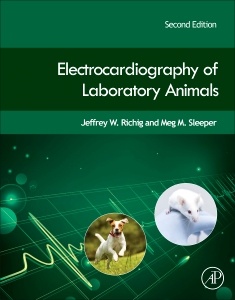Description
Electrocardiography of Laboratory Animals (2nd Ed.)
Authors: Richig Jeffrey W., Sleeper Meg M.
Language: English
Subjects for Electrocardiography of Laboratory Animals:
Keywords
Preclinical safety and safety pharmacology; Abnormalities; Atrial tachycardia (AT)AV block; Atrial tachycardia (AT)Bundle branch blocks (BBBs)Dogs; Beagle; Blood pressure (BP)High-Definition Oscillometry (HDO)Noninvasive; Bundle branch blocks (BBBs)Cats; Cynomolgus monkeys; Dog; Dogs; ECG; Electrocardiogram (ECG) and study design; Electrocardiogram (ECG)His-Purkinje system; Electrocardiogram (ECG)Minipig; Electrocardiogram (ECG)Monkeys; Electrocardiogram; Electrocardiograms; Good Laboratory Practice (GLP)International Conference on Harmonization (ICH)Safety pharmacology; Isopropyl alcohol; Lead II; Mean electrical axis (MEA)Toxicology studies; Mice; Minipigs; Neonates/Juveniles; Nonhuman primate; Nonhuman primates; Normal sinus rhythm (NSR)Premature atrial complex; Normal sinus rhythm (NSR)Respiratory sinus arrhythmia; Normal values and correction formulae; Normal values; Normal variants and abnormalities; Normal variants; Parameters; PR (PQ)QRS; Premature atrial complexes; Premature ventricular complex; Premature Ventricular complexes; Pulse wave analysis (PWA)Safety pharmacology and toxicology studies; QRS; QT; QTc; Rabbits; Rat; Rats; Restraint and electrocardiogram (ECG)Tracing; Sinoatrial (SA)Electrocardiogram (ECG; Sinus bradycardia; Sinus tachycardia; Systemic vascular resistance (SVR)Dog; Telemetry; Toxicology studies; Toxicology; Ventricular tachycardia; Waveforms
291.26 €
In Print (Delivery period: 14 days).
Add to cart120 p. · 21.4x27.6 cm · Paperback
Description
/li>Contents
/li>Biography
/li>Comment
/li>
Electrocardiography of Laboratory Animals, Second Edition, is the only publication covering electrocardiography of laboratory animals. With countries instituting requirements for the care of laboratory animals in research, this publication offers a standard on performing and analyzing ECGs. Topics covered include safety electrocardiography, toxicology, safety pharmacology, and telemetry, all important areas of discussion for biological and medical researchers, veterinarians, zoologists, and students who need to understand the electrocardiography of five species of animals used in research: canines, nonhuman primates, mini pigs, rodents (rats and mice), rabbits and cats.
1. Electrocardiography in preclinical safety2. Fundamental principles of electrocardiography3. Electrocardiography of rodents4. Electrocardiography of rabbits5. Electrocardiography of cats6. Electrocardiography of dogs7. Handling and restraint of non-human primates8. Electrocardiography of non-human primates9. Electrocardiography of neonates/juveniles10. Electrocardiography of minipigs11. Telemetry in preclinical safety studies12. PR (PQ), QRS, QT and other issues
Meg Sleeper VMD graduated from the University of Pennsylvania veterinary school cum laude in 1993. She is an associate professor of cardiology and was section chief from 2001 through 2011. Dr. Meg Sleeper has published numerous papers including over 70 peer-reviewed original papers, over 50 review papers or case reports, and 4 books. In addition to lecturing at conferences including the American Heart Association, the American College of Veterinary Internal Medicine Forum, the Keystone Veterinary Conference, the World Feline conference and the American Veterinary Medical Association (AVMA), she has been the coordinator for the small animal cardiology section at the AVMA conference since 2009. She has trained 18 veterinary cardiologists through their residency programs at the University of Pennsylvania Veterinary School. In 2015 she joined the faculty at the University of Florida veterinary school.
Dr. Sleeper is on the editorial or review board of 11 journals and has served on the research (2008-2011) and examination (2005-2008) committees for the American College of Veterinary Internal Medicine (Cardiology). In early 2011, she was appointed to the Great Ape Heart Project. This project is focused on improving cardiac health in the 4 ape species (Chimpanzees, Gorillas, Bonobos and Orangutans).
- Offers guidance in interpretation of laboratory animal ECGs by animal type
- Provides comparisons of ECGs across animal species
- Includes coverage of three animal species: canines, nonhuman primates and mini pigs, also including three additional species: rodents (rats and mice), rabbits and cats
- Supports adherence to FDA requirements of ECG performance and qualitative analysis on large laboratory animals




